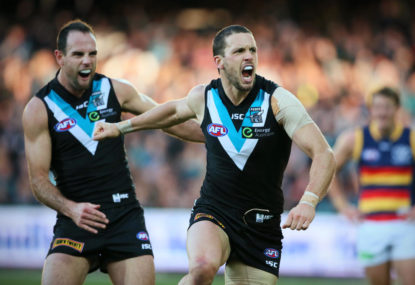Four months from now, we may well look back on Round 6 of the 2017 season as the time which the best truly separated from the rest.
With another curb stomping under their belts, Port Adelaide are now in the contender bracket.
Buried in the Saturday twilight spot, Port Adelaide once again made a lesser opposition look positively powerless. The Lions were always going to be up against it hosting the Power, but by quarter time that best case scenario had already been quashed.
Port Adelaide sprinted to a 33-point (to nothing) lead halfway through the first, and progressively built to their final margin of 73 points through a combination of ground ball victories, outside dominance and outstanding one on one defence.
Brisbane couldn’t get into any sort of rhythm, despite winning their fair share of the ball. The Lions possessed the ball for 40 per cent of the game to Port Adelaide’s 46 per cent, and had 400 disposals to Port Adelaide’s 386. In spite of this, the Lions were able to get the ball inside their attacking 50 just 38 times – the second lowest tally in the season to date – to Port Adelaide’s 67.
Play after play the Lions turned the ball over, often in the centre corridor, allowing the Power easy passage back to goal. Too often, the Lions looked for the extra handball when a kick to safety would have sufficed. It’s a familiar story for Brisbane, who’ve been playing Russian roulette with extra bullets in the gun for a few years now. Still, the manner in which the Power prosecuted the advantages afforded by their opponents was striking.
What is abundantly clear now, six rounds into the year, is the Power has the right blend of aggression, structure, ball-winning ability and hard work to make plenty of noise in this season. Three weeks ago we talked of Port Adelaide as a team worth watching; after consecutive blow-out victories, the time has come to place them in the conversation for a finish in the top four.
Port Adelaide are playing as fast as any team in the competition, able to turn open space into points better than anyone fielding humans and not Crowbots. The Power are scoring 2.3 points per minute of possession, 23 per cent (or 0.4 points per minute) above the competition average. Against the Lions, they put up 2.7 points, the best mark of the weekend and the fifth-best mark of the season to date.
They do this with a bias for action. If the numbers were available (#freethestats) I’m sure they would confirm the Power are one the leading teams for playing on from marks – their midfielders running forward through contact and looking for the next link in the chain. They exit defensive 50 with long kicks to waiting numbers, spread across the width of the ground.

Equally, Port Adelaide are willing to be patient and slow play their way up the field. With Patrick Ryder in the team, Charlie Dixon over his ankle issues, Robbie Gray playing as a permanent half forward, and Jackson Trengove and Justin Westhoff swinging from the forward half to back, there’s no shortage of marking options.
Unlike many other teams, Port Adelaide like to keep their shape up forward, breaking the zoning, help-oriented defensive schemes now common place across the competition. The Power will challenge opponents to beat them one on one, and outside of what looks to be the best two teams in the competition no one has been able to that on a sustainable basis.
It’s not dissimilar to what the Power have tried to do for the entirety of their run. The difference this season is their disposal quality has improved out of sight. Their forward 50 moves no longer look like the team is trying to push a novelty sized boulder up a steep hill – there is a fluency to their ball movement which can only come with quality delivery. To underscore this, the Power have been the best team at converting possession into forward half entries.
They’re lethal, able to torch opponents with the ball in hand and put points on the board at a rate very few teams will be able to keep up with. That’s always been Port’s strength; their weakness was winning the ball in the first place. No so in 2017: Port Adelaide’s midfield unit, battle-hardened after a solid four-year stretch together, is now a strength.
In the aggregate, Port Adelaide tend to break even with the opposition on time in possession. Their average differential per game of 0.7 minutes makes them one of the few teams in the competition with a rate around zero – most teams in 2017 are haves (Adelaide lead the league with +7.3 minutes per game) or have nots (Sydney are last with a differential of -8.4 minutes per game). For the Power, this is a big improvement on last year – they were dead, stinking last with a differential of -6.9 minutes per game.
The calculus of this is clear: if Port Adelaide were able to keep up their scoring efficiency, but tidy up their ability to win and maintain possession of the ball, the points would flow. That’s precisely what’s happened. The mechanics of it is where things get interesting.
Ken Hinkley’s most significant move of the offseason was to boot captain Travis Boak out of the starting midfield rotation and into a fifth or six man spot on the outside. It means his possession and clearance win numbers are down significantly on career marks (his three clearances and 8.8 contested possessions would be the lowest returns since 2009 if maintained over the full season).

However, he’s proving to be an effective link up man through the middle of the ground, a critical cog in transitioning play from defensive 50 to forward 50. Boak has been involved in 6.2 Port Adelaide scores per game, only down one on his career high from 2014 despite averaging five fewer disposals per game. He’s kicked six goals in five games for his troubles, too.
In his place came Sam Powell-Pepper, a born-to-run inside midfielder that does not suffer fools. Power-Pepper burst onto the scene with nasty fend after nasty fend, mixing highlights with substantive play in keeping with a player a with a few years under his belt. His 18 disposals, five clearances and eight contested possessions have been part of the reason Boak has been released from centreman duties.
The real reason is the explosion of Ollie Wines, who has bustled his way into superstar midfielder conversations of thinking fans everywhere. Wines is carrying a mountainous load for his team, averaging 28 disposals, five inside 50s, six clearances and 14 contested possession wins a game – all but the clearance number career highs.
His handball game is next level, executing deft release passes and peak Jobe Watson-style cannonballs to running teammates. He creates plenty of drive himself too, averaging 430 metres gained and a remarkable eight score involvements.
It seems churlish, but his 2017 season to date resembles Nat Fyfe’s fifth year (2014). They’re both around the same mark for disposals (Wines +1), inside 50s (Wines +1), clearances (Fyfe +2), contested possessions (Fyfe +2), tackles (even), goals (pretty well even) and have similar 50-50 disposal splits. Wines is generating about 80 metres more movement himself per game, and is involved in an extra score (likely due to Port’s higher scoring rate).
Fyfe is one of the best midfielders in the game, but it’s the kind of conversation we may be having about Wines before the year is out.
Around him, Brad Ebert is putting in a career best year as a more inside-oriented midfielder. Robbie Gray is running through as an impact player. Chad Wingard is spending more time up the ground, evidenced by his 31 touches playing as a full-time midfielder over the weekend. Ryder’s return means the Power has a genuinely unique ruckman at its disposal – his athleticism and raw leap make him a devastating weapon at stoppages.

Indeed, an interesting element to Port Adelaide’s team structure is the lack of genuine midfielders. They play plenty of forwards capable of rotating through, or outside-oriented half backs who like to use their rangey legs and long kicks to gain territory. The work of winning the ball is a team task, but it’s being left in the hands of a select few. This is potentially a weakness against the best teams, but for now it’s working just fine.
For a team many – including yours truly – thought would move sideways in 2017, the Power’s start to the year is positively shocking. Eviscerating the Lions and Blues is a sign that Hinkley has his engine humming in his fifth year as Port’s coach.
Their supercharged football now certainly has a substance which went missing over the past two seasons. Two winnable games await (against the WTF Eagles and up-and-down Suns at Jiangwan Stadium in Shanghai) before their Round 9 post-China bye, which they’ll conceivably reach at a previously-unfathomable 6-2. From there, finals is a certainty and higher honours potentially await.
The season to date has thrown up its fair share of curveballs and long tail outcomes. Port Adelaide’s fast start is one example, a pleasant cocktail of fast and fun football that looks set to carry them to September.
































































































